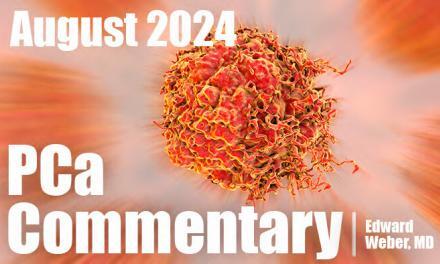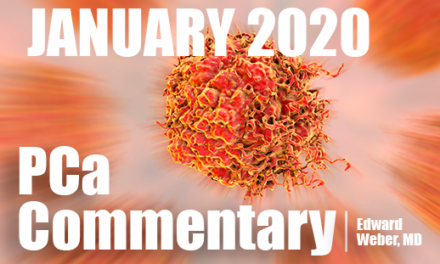
PCa Commentary | Volume 123 – June 2018
Posted by Edward Weber | June 2018
RADIOLIGAND THERAPY (RLT) with 177-LUTETIUM:
Forthcoming Treatment Option Likely to Upgrade the Management of Advanced Prostate Cancer in the Near Future.
This Commentary is prompted by two items relevant to this rapidly advancing field:
- Prostate, April 2018, published: “Meeting report from the Prostate Cancer Foundation PSMA-directed radionuclide scientific working group,” by multiple authors actively involved in research.1 This review covers basic biology, provides a summary of past studies, and highlights research aimed at improving this therapy. The Commentary will cover the main takeaway points.
- The biopharmaceutical company Endocyte announced a soon-to-be open international protocol (NCT03511664): “Study of 177Lu-PSMA-617 In Metastatic Castrate-Resistant Prostate Cancer.” This protocol will make Lu-177 RLT therapy available to 750 men with heavily treated, advanced, metastatic CRPC.
SUMMARY OF THE WORKING GROUP REPORT:
(For an in-depth discussion of Lu-177 Radioligand Therapy see PCa Commentary Vol. 117 Nov. 2017) PCa Commentary #117: RADIOLIGAND THERAPY IS FOR REAL
In Brief: PSMA Biology: PSMA is a transmembrane protein of 750 amino acids expressed on the surface of ~90-95% of prostate cancer cells, increasingly expressed as aggressiveness increases. The expression of PSMA is negatively related to androgen receptor abundance so that ADT promotes increased PSMA expression. Its normal function is to ferry nutrients such as folate and glutamate into the cell to support growth and metabolism. Short sections of this convoluted protein molecule can be targeted and linked by small molecules (e.g., “617”) or antibodies (e.g., “J591”). These molecules can be fused to radiation emitting nuclides such as Lutetium-177, Actinium-225, or several others under investigation.
Once the complex attaches to its target on the amino acid chain it is internalized and emits lethal irradiation during its 6.5 day half-life. Lu-177 is excreted via the kidney. Ninety-nine percent of PSMA is found on prostate cells but there is minor expression of PSMA on kidney tubules, salivary glands, and small intestines. Radiation from the isotope to these sites accounts for the adverse effects of Lu-177. The longer circulation time of the antibody J591 is associated with more bone marrow suppression.
Tumor heterogeneity is a challenge for achieving uniformly effective treatment with radioligand therapy: Despite the overall high cellular expression of PSMA, there can be variation in the intensity of expression among different cells. One study reported that, among circulating prostate cancer cells in CRPC patients, 43% were PSMA-positive and an equal number were PSMA-negative. PSMA is more uniformly expressed prior to Xtandi and Zytiga therapy as compared to expression in CRPC. This may have an implication as to the optimal timing of RLT.
Results of RLT to date: Treatment of prostate cancer with RLT targeted to PSMA is not new. The German experience extends back 20 years. Studies at the Peter MacCallum Cancer Centre, Australia, on efficacy, safety, and quality of life of patient have been ongoing for recent years. Research by Scott T. Tagawa, MD, MS, Weill Cornell Medical, is of 10 years duration.
The overall effectiveness of RLT in patients with advanced, heavily pre-treated cancer supports the gross generalization that 177-Lu leads to a >50% decline in PSA in > 50% of patients. Many studies reported dramatic responses in a small number of men.
The outcome of one study from Australia is especially relevant since it offered validation to support the international Endocyte trial to be discussed below. The Australian trial involved:
- 30 men with advanced metastatic cancer who displayed very avid uptake on pre-treatment PSMA PET scanning.2
- Lu-177-PSMA-617 was given intravenously for 4 cycles at 6 week intervals.
- At 12 weeks, 57% showed a > 50% PSA decline, and 43% experienced a > 80% decline.
- The median progression-free survival (mPFS) was 6.3 months, and median overall survival 12.7 months. This can be compared to those men whose PSA did not decline >50%: mPFS, 4.1; mOS, 9.9 months.
The study reported a low percentage of significant bone marrow suppression (7-13%). Also seen were dry mouth (63%), nausea (50%), vomiting (20%), fatigue (17%), and bone pain (7%).
In a German study of 200 men with heavily pre-treated disease at a mean follow-up of 16 months, Lu-177-PSMA-617 resulted in 4.5% complete responses, 33% partial, 28% stable, and 34% of men showed progressive disease. In a subset of men naive to chemotherapy, the mOS for men with >50% PSA decline was 19 months.
THE FORTHCOMING ENDOCYTE INTERNATIONAL PROTOCOL (NCT03511664):
Endocyte intends to make this protocol widely available. A posting date on the Clinical Trials site indicates that as of May 25th recruitment is open. As of the time of this Commentary, enrollment is available at the GU Research Network in Omaha (402-690-3716) and will shortly open at Weill Cornell Medical (contact research team at guonc@med.cornell.edu; for appointments call 646-962-2072). As the year progresses, patients interested in participating in this protocol should check Clinicaltrials.gov for other available locations. As the details will indicate, this trial is directed to men well along in their therapy for mCRPC whose disease has progressed through several or many courses of treatment.
The protocol: “Study of 177-Lu-PSMA-617 in Metastatic Castrate-Resistant Prostate Cancer.” The brief protocol summary states: “The primary objective of this study is to compare overall survival (OS) in patients with progressive PSMA-positive mCRPC who receive 177Lu-PSMA-617 in addition to best supportive care versus patients treated with best supportive/best standard of care alone.” Best supportive care is determined by the local investigator.
Randomization is 2:1 with twice as many assigned to the Lu-177 arm. To qualify, a patient must have progressed through either Zytiga or Xtandi and had been previously treated with 1 to 2 taxane regimens (or be unsuitable for a second chemotherapy drug). A positive 68Ga-PSMA-11 PET/CT is a requirement. Exclusion criteria should be considered by the referring physician.
*Other Protocols: Other protocols remain open as listed in the prior Commentary cited above.
*Information and videos on RLT provided by Dr. Tagawa, Weill Cornell Medical:
- Using Lutetium-177 to treat prostate cancer: https://weillcornellgucancer.org/2017/01/12/using-radiation-radioimmunotherapy-and-radioactive-isotopes-such-as-lutetium-177-to-treat-prostate-cancer/
- Explaining the protocol research into “split dosing” (fractionation) to achieve greater safety and better results: https://weillcornellgucancer.org/2016/06/04/prostate-cancer-treatment-getting-the-best-results-by-targeting-the-right-cells-at-the-right-time/
- Explaining the first ever treatment combining the antibody J591 with the alpha emitter Actinium-225: https://weillcornellgucancer.org/2017/10/27/first-ever-clinical-trial-testing-psma-targeted-antibody-and-radioactive-alpha-particles-for-treatment-of-advanced-prostate-cancer/
THE FUTURE:
The RLT of today will not be the RLT of tomorrow. Research on RLT with Lu-177 and other radioisotopes is only at an early stage of development. Work done in the past decade or so has established the groundwork for accelerated development. RLT in the future will feature different isotopes, different dosing schedules, combination therapies with both small molecules and antibodies, and RLT combined with chemotherapy. As research and experience from protocols accumulate, it is likely and desirable that RLT will move to an earlier position in the treatment sequence.
BOTTOM LINE:
Prostate cancer is nearly unique in having such a specific biomarker as the prostate-specific membrane antigen. RLT targeting of this antigen is a promising and rational therapy. As this therapy matures it is likely to have a profound and beneficial effect on prostate cancer management.
REFERENCES
- Miyahira AK, et al. Meeting report from the Prostate Cancer Foundation PSMA-directed radionuclide scientific working group. Prostate. 2018.
- Hofman MS, et al. [177Lu]-PSMA-617 radionuclide treatment in patients with metastatic castration-resistant prostate cancer (LuPSMA trial): a single-centre, single-arm, phase 2 study. Lancet Oncology. May 2018.
Your comments and requests for information on a specific topic are welcome e-mail ecweber@nwlink.com. Please also visit https://prostatecancerfree.org/prostate-cancer-news for a selection of past issues of the PCa Commentary covering a variety of topics.
“I want to thank Dawn Scott, Staffperson, Tumor Institute Radiation Oncology Group, & Mike Scully, Librarian, Swedish Medical Center for their unfailing, timely, and resourceful support of the Commentary project. Without their help this Commentary would not be possible.”
ABOUT THE AUTHOR
Edward Weber, MD, is a retired medical oncologist living in Seattle, Washington. He was born and raised in a suburb of Reading, Pennsylvania. After graduating from Princeton University in 1956 with a BA in History, Dr. Weber attended medical school at the University of Pennsylvania. His internship training took place at the University of Vermont in Burlington.
A tour of service as a Naval Flight Surgeon positioned him on Whidbey Island, Washington, and this introduction to the Pacific Northwest ultimately proved irresistible. Following naval service, he received postgraduate training in internal medicine in Philadelphia at the Pennsylvania Hospital and then pursued a fellowship in hematology and oncology at the University of Washington.
His career in medical oncology was at the Tumor Institute of the Swedish Hospital in Seattle where his practice focused largely on the treatment of patients experiencing lung, breast, colon, and genitourinary cancer and malignant lymphoma.
Toward the end of his career, he developed a particular concentration on the treatment of prostate cancer. Since retirement in 2002, he has authored the PCa Commentary, published by the Prostate Cancer Treatment Research Foundation, an analysis of new developments in the prostate cancer field with essays discussing and evaluating treatment management options in this disease. He is a regular speaker at various prostate cancer support groups around Seattle.




